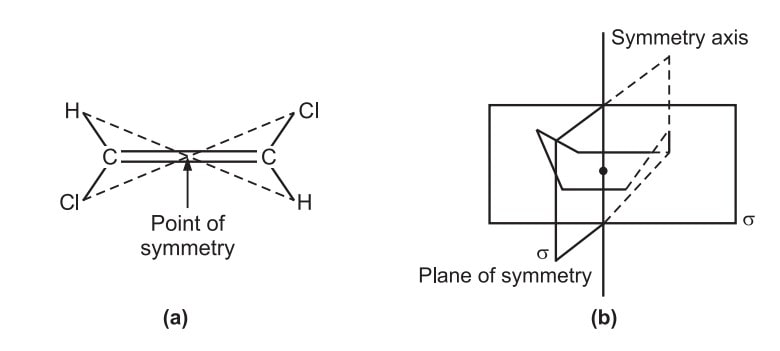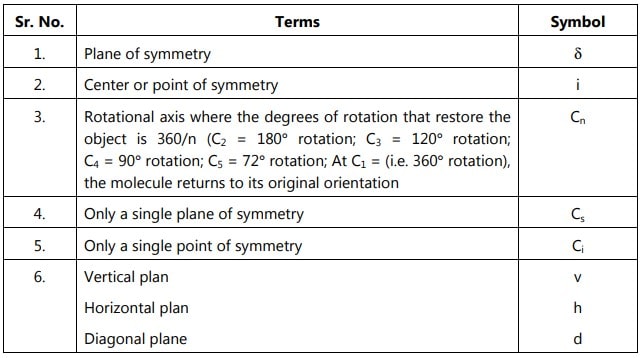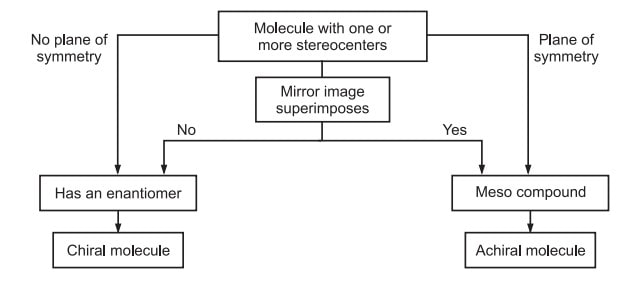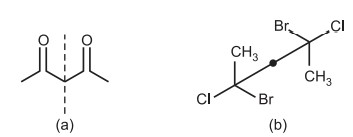In all respects, a chiral object is not identical (i.e. non-superimposable). The mirror image of an achiral object is identical (and so superimposable). There is a “handedness” to chiral things. Chiral things come in pairs, like gloves or shoes, with a right and a left. Achiral objects, like a regular round ball, do not have handedness. As a result, an object’s chirality is linked to its symmetry. Certain symmetry elements, such as a point, a line, or a plane, can be used to check a molecule’s symmetry. The object is indistinguishable from the initial orientation after being rotated or reflected around the symmetry element. Reflection means the coincidence of atoms on one side of the plane with corresponding atoms on the other side, as though reflected in a mirror.
Table of Contents
(i) Point of symmetry:
Two lines traced through the point of symmetry in a chiral molecule, (E)-1,2,-dichloroethene, assure identical structural properties at the opposing lines. Similarly, cyclohexane’s boat conformation has two crossing planes of symmetry (σ)). A plane of symmetry divides an object in such a way that, by reflection via the plane, the points on one side of the plane are equivalent to the ones on the other side.

The presence of a reflecting symmetry (a point or plane of symmetry) implies that the molecule is achiral in some way. Chiral molecules, on the other hand, can have rotational symmetry axes but no reflective symmetry elements.


Examples:
- Methane: It is an example of a high symmetry molecule having 4 C3 axes, 3 C2 axes, and 6 σ (planes). It belongs to the tetrahedral point group Td. It is achiral.
- Cis-1,2-dichloroethane: This structure has two orthogonal planes of symmetry and the C2 axis at their intersection. It is achiral.
- Trans-1,2-dichloroethane: This structure has a plane of symmetry, an orthogonal C2 axis, and a point of symmetry at their intersection. It is achiral.
- Trans-1,2-dimethylcyclopropane: This structure has only a single C2 axis. It is dissymmetric and chiral.
- Cyclohexane (boat conformation): It has a C2 axis and two planes of symmetry. It is achiral.
- Cyclohexane (chair conformation): It has planes, axes, and a point of symmetry. The principal axis is C3.
(ii) Plane of symmetry:
An achiral molecule is one that has no stereocenters. A molecule will always be chiral if it has an odd number of stereoisomers (1, 3, 5, etc.). Due to meso compounds, a molecule with an even number of stereocenters can be chiral or achiral. Aside from that, symmetry planes and inversion centers are used to determine a molecule’s chirality. Inversion centers are more difficult to spot than symmetry planes.
The plane of symmetry is the plane that divides a molecule in half so that both sides have the same properties. It can be perpendicular to the plane or parallel to it. An achiral molecule is one that has a plane of symmetry in any configuration.

(iii) Inversion center:
A plane of symmetry runs across the centre carbon in the molecule (a). A mirror plane is one in which one half of a molecule is a perfect reflection of the other half. This molecule has an achiral structure.
The molecule (b) has an inversion centre or symmetry centre. An inversion centre is a location in a molecule (which may or may not be an atom) where all other atoms can be changed into another identical component by 180 degrees. Because of the inversion core, the molecule is achiral.

Also read: Meso compounds